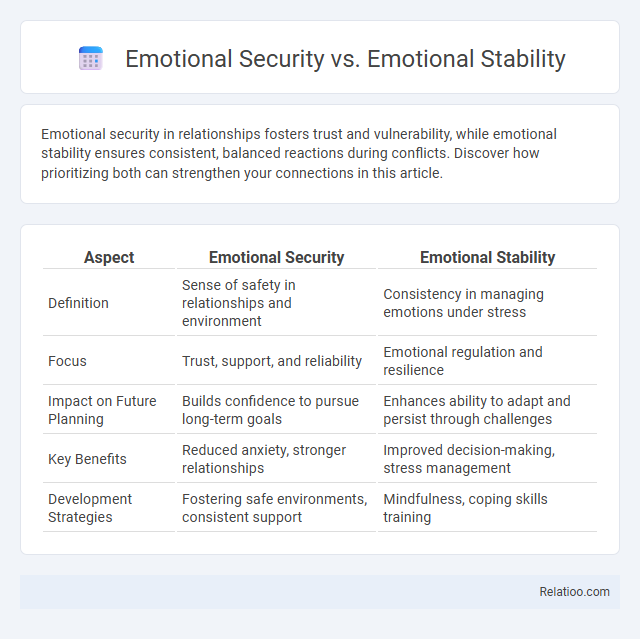Emotional security in relationships fosters trust and vulnerability, while emotional stability ensures consistent, balanced reactions during conflicts. Discover how prioritizing both can strengthen your connections in this article.
Table of Comparison
| Aspect | Emotional Security | Emotional Stability |
|---|---|---|
| Definition | Sense of safety in relationships and environment | Consistency in managing emotions under stress |
| Focus | Trust, support, and reliability | Emotional regulation and resilience |
| Impact on Future Planning | Builds confidence to pursue long-term goals | Enhances ability to adapt and persist through challenges |
| Key Benefits | Reduced anxiety, stronger relationships | Improved decision-making, stress management |
| Development Strategies | Fostering safe environments, consistent support | Mindfulness, coping skills training |
Understanding Emotional Security
Emotional security refers to a deep sense of safety in relationships and within oneself, allowing you to trust and express emotions without fear of judgment or rejection. Unlike emotional stability, which involves consistent mood regulation, emotional security emphasizes feeling protected and valued in emotional connections. Understanding emotional security is crucial for fostering healthy relationships and personal well-being, as it forms the foundation for resilience and authentic self-expression.
Defining Emotional Stability
Emotional stability refers to the ability to maintain consistent emotional responses and resist drastic mood swings despite external stressors, which is a key aspect of psychological resilience. Unlike emotional security, which involves feeling safe and confident in relationships and environments, emotional stability centers on internal regulation and control over one's emotions. Understanding emotional stability is crucial for mental health professionals aiming to support individuals in managing stress and fostering overall well-being.
Key Differences Between Emotional Security and Emotional Stability
Emotional security refers to a person's confidence in their relationships and environment, providing a sense of safety and acceptance, while emotional stability involves consistent regulation of emotions and resilience against mood swings. The key difference lies in emotional security being externally influenced by social interactions and trust, whereas emotional stability is internally governed by one's ability to manage feelings and maintain mental equilibrium. Emotional assets like secure attachments promote emotional security, whereas skills such as impulse control and self-awareness contribute to emotional stability.
The Roots of Emotional Security
Emotional security originates from early attachment experiences and stable caregiving environments that nurture trust and safety in relationships. Your sense of emotional security depends on the consistent support and understanding received during formative years, which shapes resilience and emotional regulation. Understanding these roots is crucial to distinguishing emotional security from emotional stability, where the former centers on feeling safe and accepted, while the latter pertains to managing emotions healthily over time.
How Emotional Stability Manifests in Daily Life
Emotional stability manifests in daily life through consistent mood regulation, effective stress management, and the ability to respond calmly to challenging situations. Individuals exhibiting emotional stability often maintain balanced relationships, demonstrate resilience under pressure, and adapt to change without significant emotional upheaval. This stability underpins mental well-being by reducing anxiety, enhancing decision-making, and fostering a positive outlook despite external stressors.
Common Misconceptions about Emotional Security and Stability
Emotional security is often mistaken for emotional stability, but they differ significantly: emotional security involves feeling safe and accepted in relationships, while emotional stability refers to consistent mood regulation. Common misconceptions include believing that emotional security means never experiencing negative emotions or that emotional stability requires suppressing feelings. Understanding these distinctions helps individuals foster healthier emotional responses and stronger interpersonal connections.
The Role of Relationships in Emotional Security
Emotional security in relationships provides a foundation of trust and safety that allows you to express your feelings without fear of judgment or rejection, differentiating it from emotional stability, which refers to consistent mood regulation. While emotional stability helps you manage stress and maintain calmness, emotional security is specifically nurtured through supportive connections that validate and reassure your sense of belonging. Strong relationships foster emotional security by creating an environment where vulnerabilities are accepted, contributing to overall mental well-being and resilience.
Building and Strengthening Emotional Stability
Building and strengthening emotional stability involves developing resilience to manage stress and maintain consistent emotional responses during challenges. You can enhance emotional stability by practicing mindfulness, fostering self-awareness, and establishing healthy coping mechanisms that reduce emotional fluctuations. Prioritizing emotional stability supports long-term mental well-being and improves interpersonal relationships by promoting balanced emotional regulation.
Impact on Mental Health: Security vs Stability
Emotional security provides a foundation of safety and trust, reducing anxiety and fostering resilience against stress, which significantly benefits mental health. Emotional stability, characterized by consistent mood regulation and balanced responses, helps prevent mood disorders and promotes overall psychological well-being. While both security and stability are crucial, emotional security anchors mental health by creating a safe internal environment, whereas stability maintains equilibrium in emotional experiences.
Strategies for Achieving Both Emotional Security and Stability
Developing consistent self-awareness practices and fostering open, honest communication are essential strategies for achieving emotional security and stability. Establishing healthy boundaries and engaging in regular stress management techniques, such as mindfulness and cognitive-behavioral approaches, reinforce resilience and emotional regulation. Prioritizing supportive relationships and seeking professional guidance when necessary contribute significantly to maintaining both emotional security and long-term emotional stability.

Infographic: Emotional Security vs Emotional Stability
 relatioo.com
relatioo.com